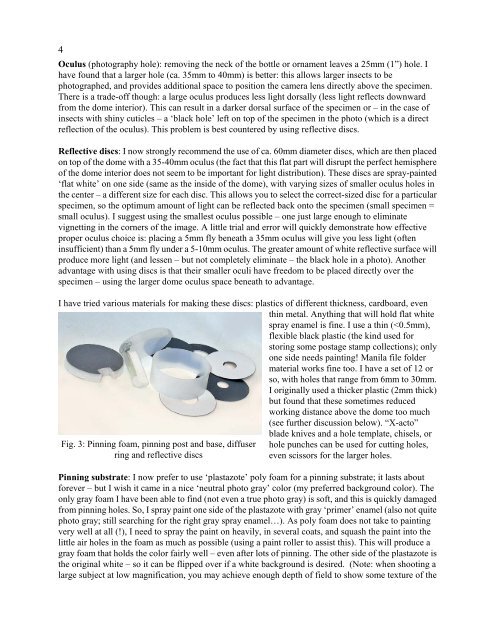Fly Times Issue 48, April 2012 - North American Dipterists Society
Fly Times Issue 48, April 2012 - North American Dipterists Society
Fly Times Issue 48, April 2012 - North American Dipterists Society
Create successful ePaper yourself
Turn your PDF publications into a flip-book with our unique Google optimized e-Paper software.
4<br />
Oculus (photography hole): removing the neck of the bottle or ornament leaves a 25mm (1”) hole. I<br />
have found that a larger hole (ca. 35mm to 40mm) is better: this allows larger insects to be<br />
photographed, and provides additional space to position the camera lens directly above the specimen.<br />
There is a trade-off though: a large oculus produces less light dorsally (less light reflects downward<br />
from the dome interior). This can result in a darker dorsal surface of the specimen or – in the case of<br />
insects with shiny cuticles – a ‘black hole’ left on top of the specimen in the photo (which is a direct<br />
reflection of the oculus). This problem is best countered by using reflective discs.<br />
Reflective discs: I now strongly recommend the use of ca. 60mm diameter discs, which are then placed<br />
on top of the dome with a 35-40mm oculus (the fact that this flat part will disrupt the perfect hemisphere<br />
of the dome interior does not seem to be important for light distribution). These discs are spray-painted<br />
‘flat white’ on one side (same as the inside of the dome), with varying sizes of smaller oculus holes in<br />
the center – a different size for each disc. This allows you to select the correct-sized disc for a particular<br />
specimen, so the optimum amount of light can be reflected back onto the specimen (small specimen =<br />
small oculus). I suggest using the smallest oculus possible – one just large enough to eliminate<br />
vignetting in the corners of the image. A little trial and error will quickly demonstrate how effective<br />
proper oculus choice is: placing a 5mm fly beneath a 35mm oculus will give you less light (often<br />
insufficient) than a 5mm fly under a 5-10mm oculus. The greater amount of white reflective surface will<br />
produce more light (and lessen – but not completely eliminate – the black hole in a photo). Another<br />
advantage with using discs is that their smaller oculi have freedom to be placed directly over the<br />
specimen – using the larger dome oculus space beneath to advantage.<br />
I have tried various materials for making these discs: plastics of different thickness, cardboard, even<br />
thin metal. Anything that will hold flat white<br />
spray enamel is fine. I use a thin (
















